Articles
- Page Path
- HOME > Korean J Community Nutr > Volume 22(1); 2017 > Article
-
Research Article
- Comparison of Nutritional Status and Eating Behavior of Korean and Chinese Children using the Nutrition Quotient (NQ)
-
Hua Ling, Hokyung Ryu

-
Korean Journal of Community Nutrition 2017;22(1):22-39.
DOI: https://doi.org/10.5720/kjcn.2017.22.1.22
Published online: February 28, 2017
Department of Food Science and Nutrition, Pusan National University, Busan, Korea.
- Corresponding author: Hokyung Ryu. Department of Food Science and Nutrition, Pusan National University, 2, Busandaehak-ro 63beon-gil, Geumjeong-gu, Busan 46241, Korea. Tel: (051) 510-7397, Fax: (051) 583-3648, hokryu@pusan.ac.kr
Copyright © 2017 The Korean Society of Community Nutrition
This is an Open-Access article distributed under the terms of the Creative Commons Attribution Non-Commercial License (http://creativecommons.org/licenses/by-nc/3.0/) which permits unrestricted non-commercial use, distribution, and reproduction in any medium, provided the original work is properly cited.
- 1,250 Views
- 5 Download
- 2 Crossref
Figure & Data
REFERENCES
Citations

- Assessment of the dietary quality among Chinese adults living in Shanghai and the Anhui Province using the Nutrition Quotient for adults
Ani Liu, Ji-Yun Hwang
Journal of Nutrition and Health.2025; 58(1): 117. CrossRef - Diet-Related Disparities and Childcare Food Environments for Vulnerable Children in South Korea: A Mixed-Methods Study
Jiyoung Park, Seolhyang Baek, Gahui Hwang, Chongwon Park, Sein Hwang
Nutrients.2023; 15(8): 1940. CrossRef
Democratic characteristics of the children
1) N (%)
2) Lower grades (1 – 3): 6 – 9 years old, Upper grades (4 – 6): 10 – 12 years old
3) Without children: Food secure 0 – 2, Food insecure without hunger 3 – 5, Food insecure with hunger (moderate) 6 – 8, Food insecure with hunger (severe) 9 – 10. With children: Food secure 0 – 2, Food insecure without hunger 3 – 7, Food insecure with hunger (moderate) 8-12, Food insecure with hunger (severe) 13 – 18.
*: p < 0.05, ***: p < 0.001
Physical status of children
1) Values are Mean±SD.
2) Korean: Based on growth charts for Korean Children and adolescents (2007), Underweight: BMI percentile < 5, Normal weight: 5 ≤ BMI percentile < 85, Overweight: 85 ≤ BMI percentile < 95, Obesity: BMI percentile ≥ 95. Chinese: Underweight: Screening standard for malnutrition of school-age children and adolescents (WS/T 456-2014). Normal weight, Overweight, Obesity: Body mass index growth curves for Chinese children and adolescents aged 0 to 18 years (H Li,CY Ji, XN Zong, YQ Zhang 2009).
3) N (%)
**: p < 0.01
NQ score and NQ grades of children between Korean and Chinese
1) Factor score = sum of [checklist item score (0 – 100) × rounded item weight within a factor], NQ score = sum of [checklist item score (0 – 100) × item weight within NQ
2) Values are Mean±SD.
3) Highest (100~80.9), High (73.8~80.8), Medium (56.5~73.7), Low (47.6~56.4), Lowest (0~47.5)
4) N (%)
*: p < 0.05, **: p < 0.01, ***: p < 0.001
NQ score and NQ grades of Chinese children by food security
1) Without children: Food secure 0 – 2, Food insecure without hunger 3 – 5, Food insecure with hunger (moderate) 6 – 8, Food insecure with hunger (severe) 9 – 10. With children: Food secure 0 – 2, Food insecure without hunger 3 – 7, Food insecure with hunger (moderate) 8 – 12, Food insecure with hunger (severe) 13 – 18.
2) Values are Mean±SD.
3) Best (100~80.9), Excellence (73.8~80.8), Ordinary (56.5~73.7), Imperfectly (47.6~56.4), Bad (0~47.5)
4) N (%)
*: p < 0.05, **: p < 0.01, ***: p < 0.001
Comparison of checklist items for balance factor
1) N (%)
*: p < 0.05, **: p < 0.01, ***: p < 0.001
Comparison of checklist items for diversity factor
1) N (%)
***: p < 0.001
Comparison of checklist items for moderation factor
1) N (%)
*: p < 0.05, ***: p < 0.001
Comparison of checklist items for regularity factor
1) N (%), ***: p < 0.001
Comparison of checklist items for practice factor
1) N (%), *: p < 0.05, **: p < 0.01, ***: p < 0.001
Relationship of children's NQ score with parent's practicing score of Dietary Guidelines
Partial correlation coefficients
Adjusted for nationality, gender, grade, father's educational level, mather's educational level, food secure
*: p < 0.05, **: p < 0.01, ***: p < 0.001
1) N (%) 2) Lower grades (1 – 3): 6 – 9 years old, Upper grades (4 – 6): 10 – 12 years old 3) Without children: Food secure 0 – 2, Food insecure without hunger 3 – 5, Food insecure with hunger (moderate) 6 – 8, Food insecure with hunger (severe) 9 – 10. With children: Food secure 0 – 2, Food insecure without hunger 3 – 7, Food insecure with hunger (moderate) 8-12, Food insecure with hunger (severe) 13 – 18. *: p < 0.05, ***: p < 0.001
1) Values are Mean±SD. 2) Korean: Based on growth charts for Korean Children and adolescents (2007), Underweight: BMI percentile < 5, Normal weight: 5 ≤ BMI percentile < 85, Overweight: 85 ≤ BMI percentile < 95, Obesity: BMI percentile ≥ 95. Chinese: Underweight: Screening standard for malnutrition of school-age children and adolescents (WS/T 456-2014). Normal weight, Overweight, Obesity: Body mass index growth curves for Chinese children and adolescents aged 0 to 18 years (H Li,CY Ji, XN Zong, YQ Zhang 2009). 3) N (%) **: p < 0.01
1) Factor score = sum of [checklist item score (0 – 100) × rounded item weight within a factor], NQ score = sum of [checklist item score (0 – 100) × item weight within NQ 2) Values are Mean±SD. 3) Highest (100~80.9), High (73.8~80.8), Medium (56.5~73.7), Low (47.6~56.4), Lowest (0~47.5) 4) N (%) *: p < 0.05, **: p < 0.01, ***: p < 0.001
1) Without children: Food secure 0 – 2, Food insecure without hunger 3 – 5, Food insecure with hunger (moderate) 6 – 8, Food insecure with hunger (severe) 9 – 10. With children: Food secure 0 – 2, Food insecure without hunger 3 – 7, Food insecure with hunger (moderate) 8 – 12, Food insecure with hunger (severe) 13 – 18. 2) Values are Mean±SD. 3) Best (100~80.9), Excellence (73.8~80.8), Ordinary (56.5~73.7), Imperfectly (47.6~56.4), Bad (0~47.5) 4) N (%) *: p < 0.05, **: p < 0.01, ***: p < 0.001
1) N (%) *: p < 0.05, **: p < 0.01, ***: p < 0.001
1) N (%) ***: p < 0.001
1) N (%) *: p < 0.05, ***: p < 0.001
1) N (%), ***: p < 0.001
1) N (%), *: p < 0.05, **: p < 0.01, ***: p < 0.001
Partial correlation coefficients Adjusted for nationality, gender, grade, father's educational level, mather's educational level, food secure *: p < 0.05, **: p < 0.01, ***: p < 0.001

 KSCN
KSCN
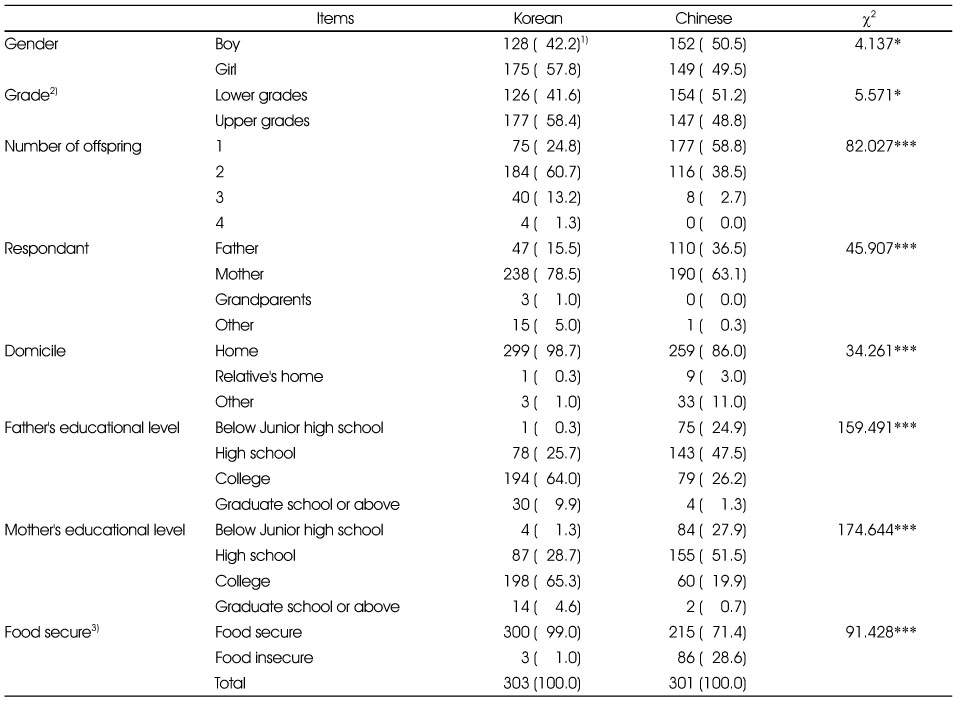


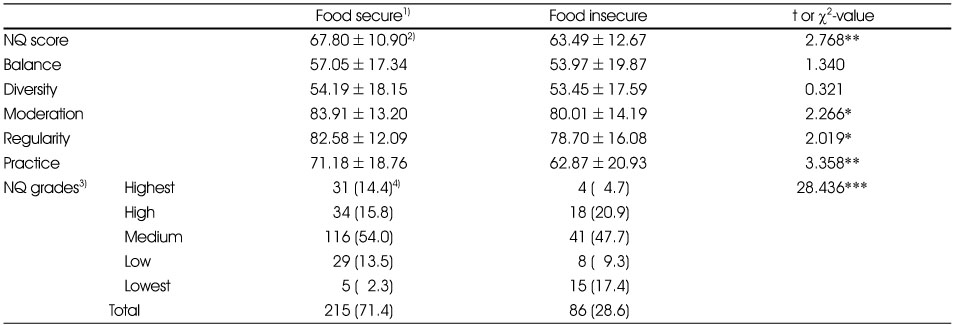
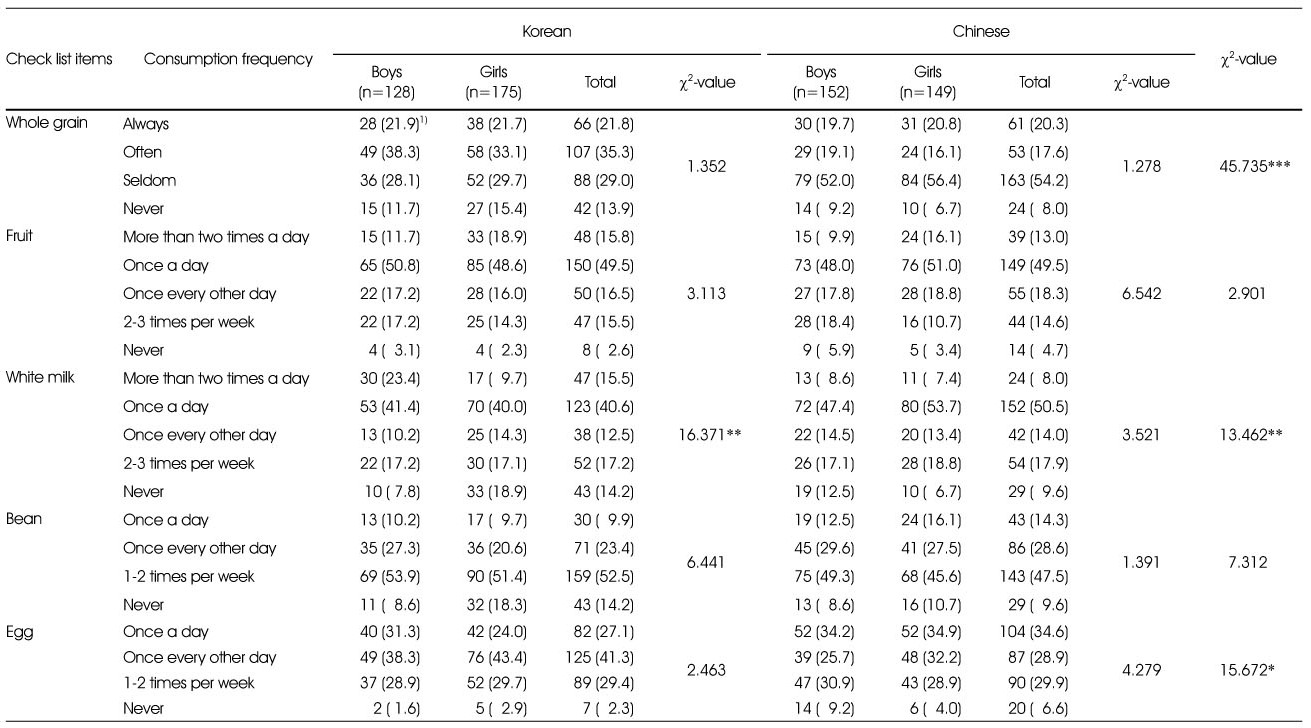
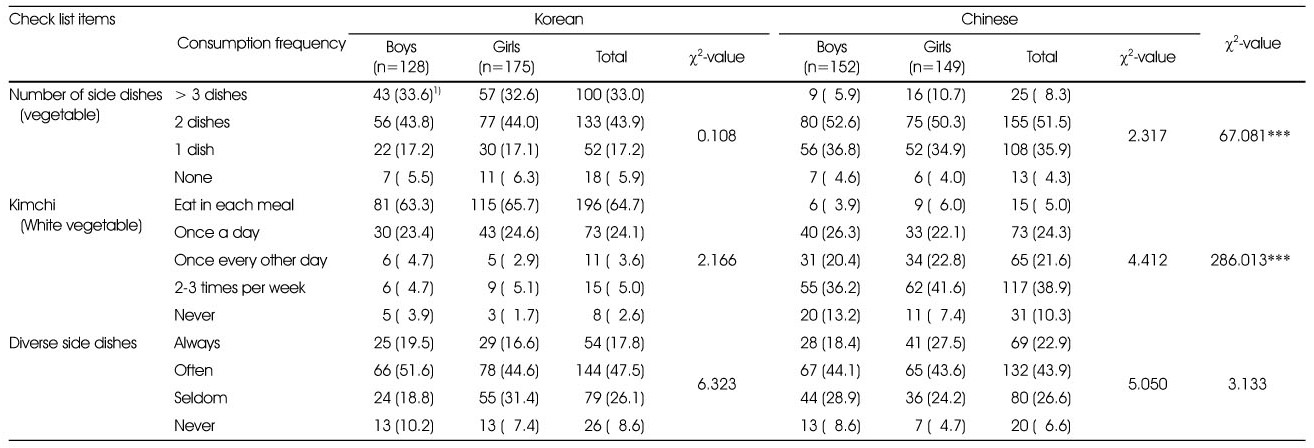
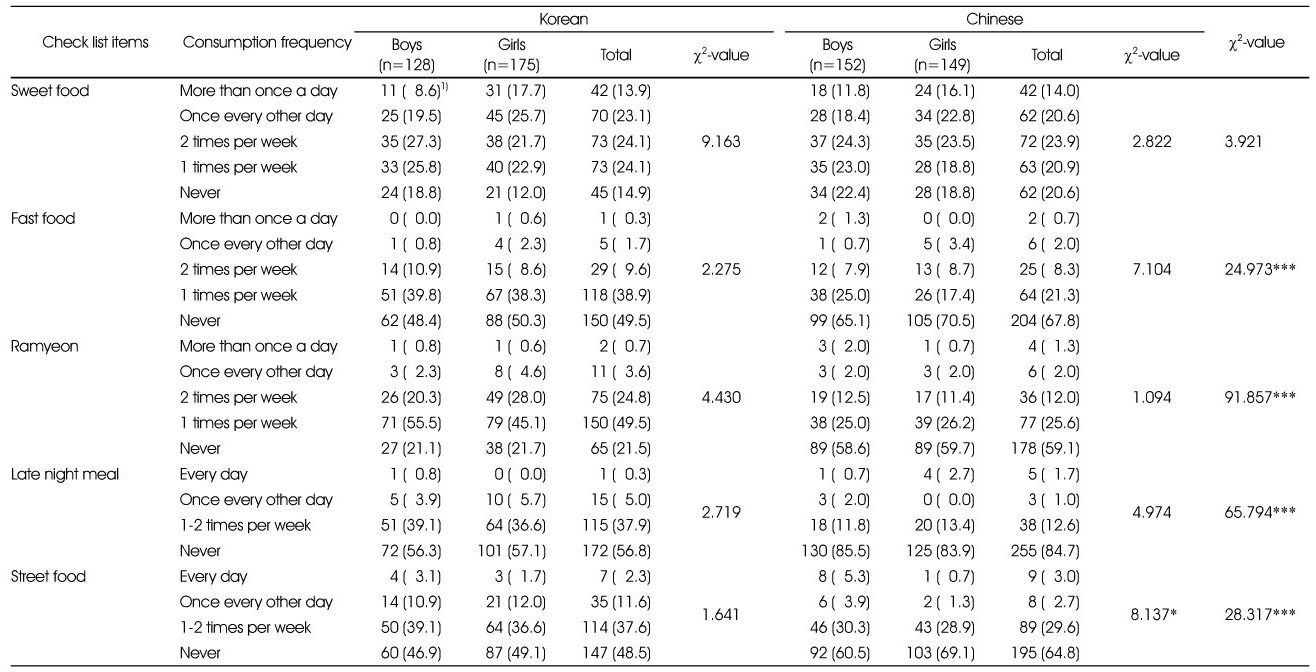

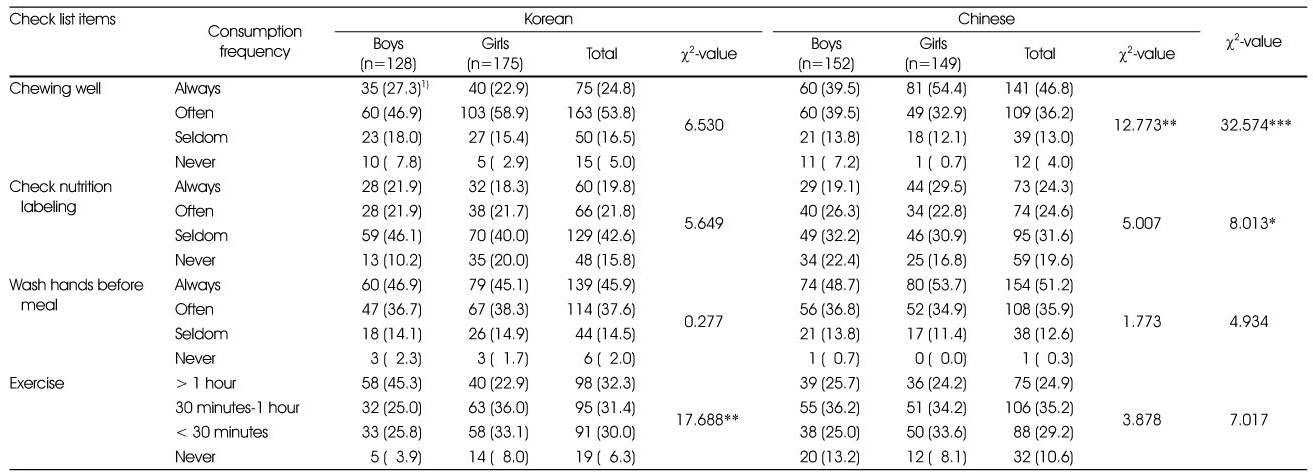

 Cite
Cite


